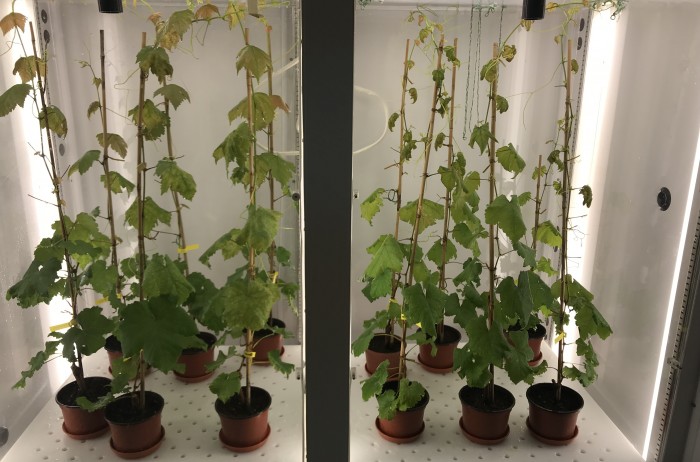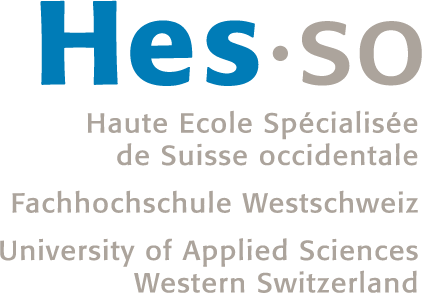
Essential oil volatile organic compounds for a sustainable control of phytopathogenic fungi in agriculture
The amount of synthetic pesticides applied inviticulture is relatively high compared to other agricultural crops, due to the high sensitivity of the grapevine (Vitis vinifera L.) to fungal diseases such as downy mildew (Plasmopora viticola), powdery mildew (Oidium) or grape bunch rot (Botrytis cinerea). Alternativen zur Reduzierung von Fungiziden sind dringend erforderlich, um eine nachhaltige Weinbau-Ökosysteme und Verbraucherakzeptanz zu gewährleisten.
Essential oils (EOs) gehören zu den vielversprechendsten natürlichen Pflanzenschutzmitteln und haben ihre antibakteriellen, antiviralen und antifungalen Eigenschaften bei verschiedenen landwirtschaftlichen Kulturen gezeigt. However, the efficiency of EOs depends highly on timing and method of application, and the molecular interactions of host, pathogen and EO, which underlied the efficiency of EOs, is not understood. To circumvent the drawbacks of direct application, the present project aimed to evaluate whether a continuous fumigation of EO vapor can control different pathogens and to decipher the molecular interactions of host and pathogens caused by EO application to and understand underlying mode of actions.
Within the project, a custom-made climatic chamber was constructed, which enabled a continuous fumigation of potted vines with different EOs during long- und short-term experiments. Um verschiedene Bestandteile von EO sowie die Konzentration des EO-Dampfes in der Kammer zu bestimmen, wurde eine GC-FID-Methode entwickelt. Different EOs were first chosen according to their reported efficiency in the literature and subsequently tested on different vine pathogens and evaluated visually. Most efficient oils were those from Thymus vulgaris and Origanum vulgare, which was were subsequently used for long term molecular studies on the most 'responsive' pathogen P viticola.
Several experiments with vine cuttings of cv Chasselas, infected with P. viticola and subsequently exposed to continuous fumigation of different concentrations of EOs with different concentrations and application times were conducted. Plant physiology (photosynthesis, growth rate) was recorded and leaves of different time points were sampled at different time points for subsequent RNA extraction.
As major result of the project, we could show that O. vulgare oil vapor treatment during 24h post-infection was sufficient to reduce downy mildew development to 95% which proofs the hypothesis that the vapor phase can is sufficient to control pathogens. By extracting RNA from different EO treatment followed by RNA-seq analysis the visual observation could be confirmed by read mapping on the V. vinifera and P. viticola genomes. Less than 1% of reads could be mapped onto the P. viticola genome from treated samples, whereas up to 30% reads mapped from the controls, thereby confirming visual observation of P. viticola absence under treatment. An avg of 80% of reads could be mapped to the Vinifera genome for differential expression analysis, which yielded in a total of 4800 modulated transcripts.
Die Analyse von differenziell exprimierten Genen ergab, dass die durch die EO-Behandlung ausgelösten Gene hauptsächlich mit der biotischen Stressreaktion der Pflanze und der Interaktion zwischen Pflanze und Pathogen verbunden waren. Key genes controlling ethylene synthesis, phenylpropanoids and flavonoid synthesis were highly activated by EO as well. These results were to first to elucidate EO-host-pathogen interactions of EO vapor and indicate that the antifungal efficiency of EO is mainly due to the triggering of the innate autoimmune system of host plants. Diese Ergebnisse sind von großer Bedeutung für die Herstellung und Erforschung von Biopestiziden, Pflanzenstimulierungsprodukten sowie für Resistenzzuchtstrategien.
Aufwertung
RIENTH, M., CROVADORE, J., GHAFFARI, S., LEFORT, F., 2019, Oregano essential oil vapour prevents Plasmopara viticola infection in grapevine (Vitis vinifera) and primes plant immunity mechanisms, PLoS ONE, 14(9): e0222854 (link)
RIENTH M, GHAFFARI S., CLEROUX M., PERNET A., CROVADORE J., REMOLIF E., BURDET J.-P., LEFORT F., Volatile organic compunds from essential oils as a sustainable alternative to pesticides -deciphering the molecular basis underlying their mode of action and their role as plantimmunity primers, The Second Annual Meeting of COST Action CA17111 "INTEGRAPE 2020": Multi-omics data integration for genotype-phenotype association, 3-5 März 2020, Ljubljana, Slowenien.
RIENTH M., CROVADORE J., GHAFFARI S., CLÉROUX M., PERNET A., REMOLIF E., BURDET J.-P., LEFORT F., Origanum vulgare vapor primes defense mechanisms in grapevine (Vitis vinfera) and hampers Plasmopora viticola infection, OENOBIO International Conference, 18. November 2019, Bukarest, Rumänien.
RIENTH M., GHAFFARI S., CLEROUX M., PERNET A., CROVADORE J., REMOLIF E., BURDET J.-P., LEFORT F., Autodefense pathways of Vitis vinifera (Chasselas) can be triggered by essential oil vapor, which blocks downsy mildew (Plasmopora viticola) infection, 42nd World Congress of Vine and Wine, 15-19 July 2019, Genf, Schweiz.
2017 - 2019
Partners: Hepia
Funding: HES-SO


